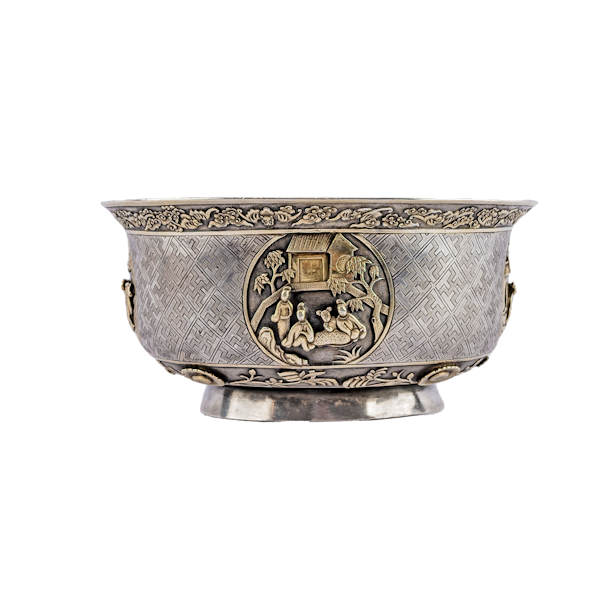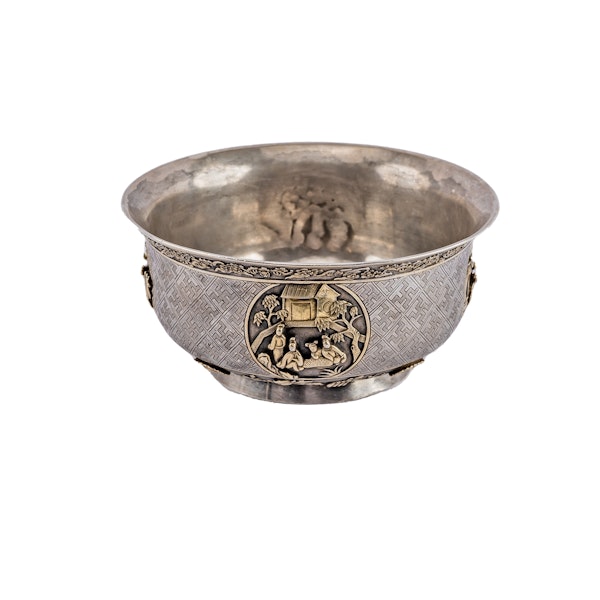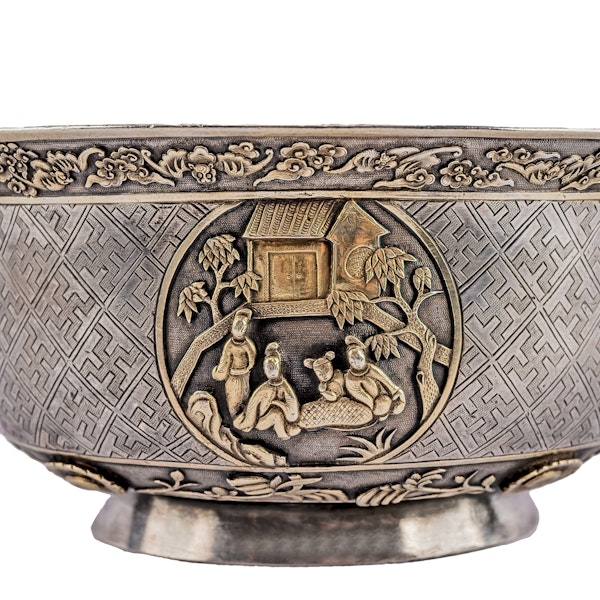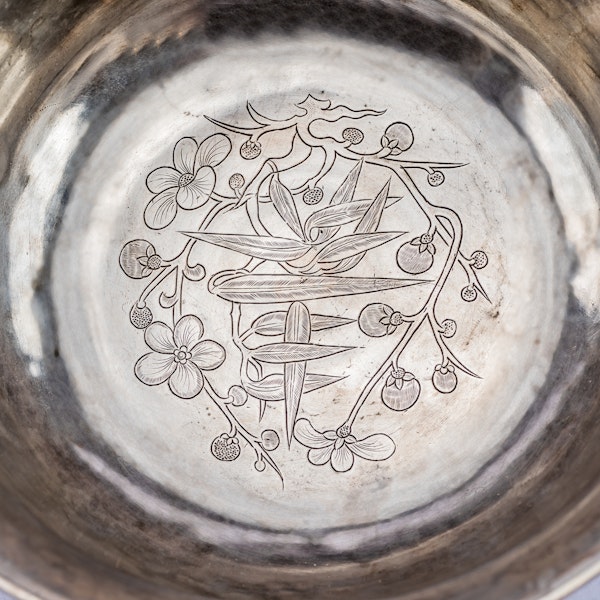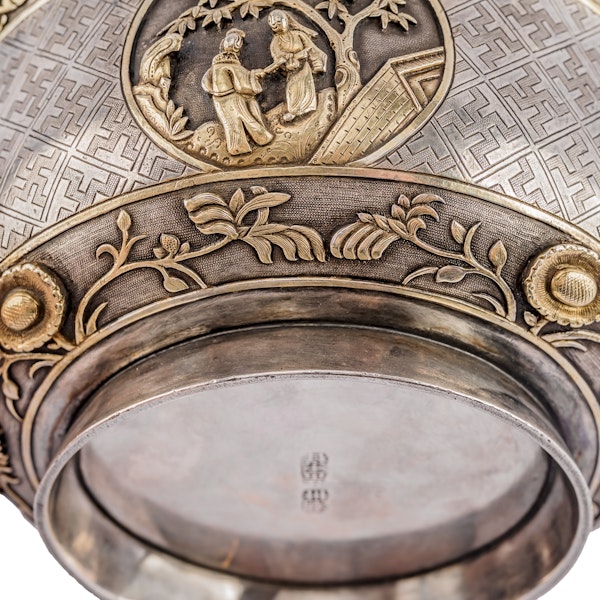Antique Chinese Silver & Parcel-Gilt Bowl, Medallions - Chaozhou, (Chao Zhou) ( 潮州), China, late 19th Century
Antique Chinese Silver & Parcel-Gilt Bowl, Medallions - Chaozhou, (Chao Zhou) ( 潮州), China, late 19th Century
POA
Description
Antique Chinese Silver & Parcel-Gilt Bowl, Medallions - Chaozhou, (Chao Zhou) ( 潮州), China, late 19th Century
This unusual and extremely stylish Chinese silver and parcel-gilt pedestal bowl would grace any silver collection. The bowl is covered in auspicious and felicitous symbols, inside and out. It was made in Chao Zhou, China, in the last quarter of the nineteenth century, possibly for export to the South-East Asian market.
The whole of the exterior surface of the bowl, excluding the underside of the base, is covered in ornamentation. The design is very bold and extremely confident, with a sense of the dramatic and it has been executed superbly. It is very unusual to find parcel gilt Chinese silver from this period. The design has been inspired by porcelain from the Ming dynasty.
To the interior surface, around the base of the well, is a pleasing depiction of a plum tree bearing blossom and fruit, together with bamboo. When bamboo and plum are featured together, they represent marriage and the hope that the union proves fruitful. The bamboo leaves have been carefully arranged to form the Chinese character for long life. The bowl was almost certainly commissioned to celebrate a marriage and to wish all good things including long life and many children to the newly married couple.
To the underside of the bowl are clear Chinese character marks. We understand they state the name of the retailer, Huang Gan Xiang, and the city of manufacture, Chaozhou, a large and historic city in the Guangdong province of China.
Around ten million of Chaozhou’s population speak the Teochow dialect rather than Mandarin. Teochow people form the largest ethnic Chinese group living in Thailand and Cambodia and the second largest Chinese ethnic group living in Singapore. There are around two and a half million Teochow people living overseas, mainly in South-East Asia. This raises the possibility that the bowl was not made for the home market but for export, probably to Thailand. As a result of their common language, the Teochow people of Chaozhou enjoyed excellent trading relationships with their counterparts overseas, particularly those living in South-East Asia, in the countries bordering the historic Maritime Silk Road.
The bowl stands on a conical pedestal foot of plain silver. This is balanced by the outwardly flaring conical rim to the top of the bowl. Immediately under the rim lies a border worked in repousse and chased techniques, showing bats flying amongst the clouds. Clouds are considered lucky as they bring the rain to water the crops, which ensures a good harvest. In combination with bats, they symbolise an even stronger wish for good luck and good fortune. The background of the panels has been finely punched and the high relief areas have been gilded as have the narrow gilt wire borders which frame the borders and panels.
The border to the base of the bowl contains four large sunflower heads linked by arching foliate branches or vines, one marking each quadrant. These have been created using repousse and chasing and have been gilded, providing a strong contrast to the finely punched, silver background. Whilst the sunflower heads are still attached to the plant, they always turn to face the sun, constantly adjusting their position and tracking the sun as it moves across the sky. In Chinese art, the sunflower symbolises longevity, good fortune, vitality, intelligence, happiness and faithfulness. This border is also finished by narrow gilt silver borders to the upper and lower edges, echoing the style of the upper border and providing balance and harmony.
To the centre of the bowl, are four large medallions or tondos, depicting charming vignettes of courtship and young love, one placed at each quadrant. The medallions stretch from the upper to the lower borders and have been slightly cropped at the tops and bottoms so that the central area of the panels can be at a larger scale. The scenes have been superbly executed using repousse, chasing and engraving techniques and are finely detailed. The areas of high relief have been gilded and each medallion is encircled by a simple raised wire frame, which has also been gilded.
The four scenes of the medallions depict courtship:-
The suitor has arrived at the bridge near to the family home and is being greeted by the girl’s father.
The family and the suitor relax together in the garden, enjoying a board game, thought to be Go.
The suitor and the young lady are alone in a quiet area of the garden. The suitor is removing a scroll, probably a love poem, from his sleeve and presenting it to the lady.
The departure of the suitor on horseback. Mother and daughter are seeing him off after he has partaken of refreshments before his journey. The daughter bows her head deferentially and holds the bowls which contained the refreshment.
The background between the medallions has been finely engraved with a strong repeating diamond shaped geometric double trellis or lattice, with each of the diamond shaped spaces between the struts containing an identical symbol; a swastika or sv-asti, meaning ‘so be it’ in Sanskrit. The sv-asti have this Buddhist meaning but also a secular meaning. The ground of the swastika motives has been finely punched and this surface treatment defines the symbols whilst creating a subtle but very effective tonal contrast to the reflective plain silver surrounding them. The punched surface also provides textural variation. This clever backdrop provides interest whilst allowing the roundels to dominate the space and draw the eye.
In Buddhist paintings the swastika symbolises the heart of The Buddha. This ancient Indian motif is regarded as a good luck symbol there but in China, is more associated with a wish for long life, representing the endless turning of the wheel of life through multiple reincarnations. This motif’s four-fold symmetry softly echoes the four roundels around the centre of the bowl and the four sunflowers around the lower border.
Regarding the background, it is exceedingly difficult to execute such a strong and large linear grid on a curving surface. It requires meticulous planning and absolute precision, with numerous small adjustments along the way to compensate for the curvature of the surface.
| item details | |
|---|---|
| Origin | Chinese |
| Period | 19th Century |
| Style | Other |
| Condition | Excellent |
| Dimensions | H:8.6cm W:17.4cm |
| Diameter | Weight: 982 Grams |
Product REF: 10014
